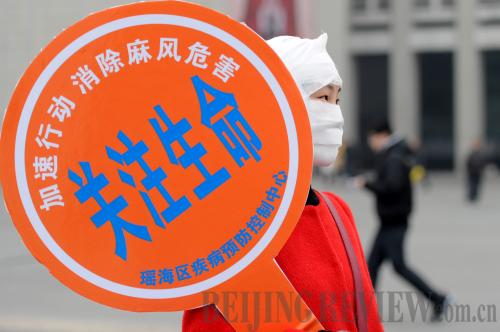|
 |
|
AWARENESS CAMPAIGN: A staff member from a local center for disease control and prevention dressed like a leprosy patient with bandage holds a cardboard written with the slogan of leprosy prevention on the square of the Hefei Railway Station in Hefei, east China's Anhui Province, on January 27, the 60th World Leprosy Day (LIU JUNXI) |
Farmers' Insurance
China will include more serious diseases in its existing rural medical insurance system in 2013, the Ministry of Health said in an annual work agenda published on January 25.
According to the agenda, pilot programs will be launched to ensure that rural children with two types of severe urological disorders—among other diseases that the plan did not elaborate on—have their medical expenses reimbursed under the rural cooperative medical cooperative program.
China launched the rural insurance scheme in 2003 to ensure that the country's vast number of rural residents have access to affordable medical treatment and to reduce disease-triggered poverty. Under the program, both governments and individuals contribute funds.
As of 2012, the scheme covers 20 serious diseases, up from two in June 2010, when serious diseases were first included in the reimbursement plan.
According to the ministry's agenda, the annual government subsidy for participants in the rural healthcare scheme will be raised by 40 yuan ($6.43) to 280 yuan ($45.02) in 2013.
Participants will have 75 percent of their inpatient expenses reimbursed under the rural cooperative medical program and coverage for outpatient costs will be increased, it said.
In 2013, individuals will each pay a 60-yuan ($9.65) premium, bringing the total funds pooled for each person to 340 yuan ($54.66)), up from 290 yuan ($46.62) in 2012. In 2003, the average fund pooled for each person was 30 yuan.
Official statistics show that the number of people covered by the program skyrocketed from 80 million in 2003 to nearly 900 million in 2012.
Emissions Targets
China has set a new emissions reduction target for 2013 by promoting an aggregate indicator budget control system for major pollutants, the minister of environmental protection said on January 24.
Emissions of organic water pollutants and sulfur dioxide in 2013 will be reduced by 2 percent year on year, while that of ammonia nitrogen and nitrogen oxides will fall by 2.5 percent and 3 percent, respectively, said Minister of Environmental Protection Zhou Shengxian.
The emissions of four major pollutants—sulfur dioxide, nitrogen oxides, organic water pollutants and ammoniacal nitrogen—dropped at least 2 percent in 2012, Zhou said at a national meeting.
Zhou said that PM2.5 will be included in the country's major pollutant monitoring and measuring system.
This year the country will start monitoring six major pollution indicators, including PM2.5, in 113 cities on the state environmental protection list, he said.
Medical Awards
A total of 85 Chinese research findings in medical and health fields have received the country's most authoritative scientific awards for their inventions in the field,
Chinese Medical Association (CMA) announced on January 27.
The Chinese Medical and Technology Award, approved by the Ministry of Health and the Ministry of Science and Technology in 2001 and set up by the CMA, was the highest annual award in the medical and health field.
Among the eight first prize winners was a micro-invasive treatment research and its clinical application for bone fractures, which will be qualified to pursue higher prizes such as the national awards for natural science or technological invention.
Twenty-five findings, including the application of proteomics in the treatment of critical illnesses, took second prize, with the rest being awarded third prize. | 